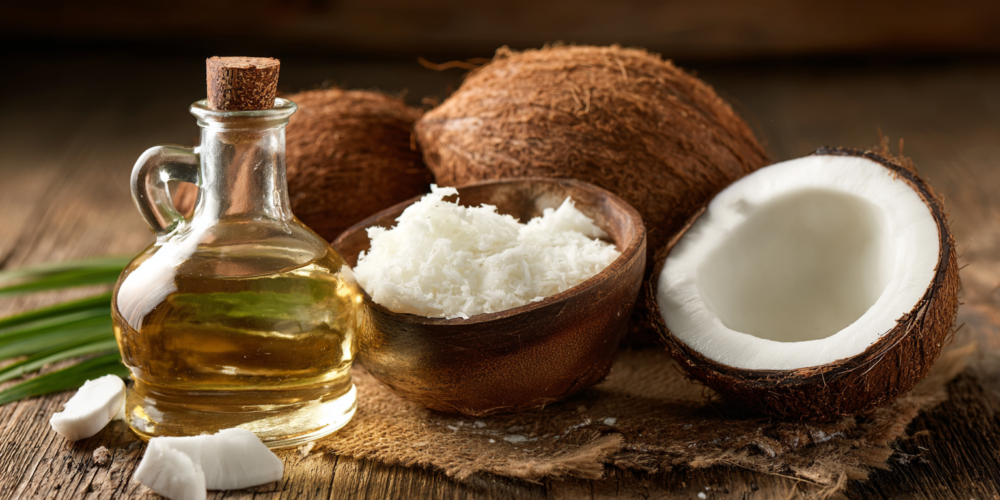
Choosing the right cooking oils can be a bit of a puzzle, right? It seems like every other day there’s a new study or a new trend telling us what’s good and what’s not. But here’s the thing: not all oils are created equal. Some are fantastic for your heart and brain, while others, even those that look healthy, might be hiding some real dangers. This article will help you figure out which oils are your allies in the kitchen and which ones you should probably ditch for good. We’ll look at six oils that can really boost your health, talk about the top pick, and show you how to use them to get all their good stuff.
✅6. The Coconut Oil Comeback: More Than Just a Tropical Treat

When you think of healthy oils, coconut oil might not be the first one that pops into your head. For years, we were told that saturated fats were the bad guys, but coconut oil has a secret that changes everything. Not all saturated fats act the same way in your body. The ones in coconut oil are different. They have something called medium-chain triglycerides, or MCTs. These MCTs are like a special fuel for your brain.
When you have a spoonful of virgin coconut oil, your liver turns these MCTs right into ketones. Ketones are pure energy for your brain cells. They don’t need insulin to get into your cells; they go straight to work. That’s why a lot of people feel more mentally clear when they have it in the morning.
But there’s more to it. Virgin coconut oil has lauric acid, which acts like a protective shield. It fights off harmful viruses, bacteria, and fungi. It’s the same protective stuff found in breast milk. And here’s something interesting: this oil helps your gut in a special way. It makes your gut barrier stronger, which is like the walls of a castle. If those walls are weak, bad stuff can get in. If they’re strong, they protect you. A little bit in your morning coffee can help keep those walls sturdy.
Virgin coconut oil is also packed with antioxidants. Every time you breathe, eat, or get stressed, your body makes free radicals. These are like sparks that can start fires in your cells, and the antioxidants in coconut oil put out those sparks.
How you use it matters a lot. If you heat it too much, you lose some of its good qualities. It’s best to add it to warm (but not boiling) drinks or use it for light sautéing. You can also just take it straight, maybe half a spoonful in the morning and another in the afternoon. And it’s not just for eating; your skin and hair can benefit too. Coconut oil goes deep into your skin, hydrating it from the inside. For your hair, use it as a mask once a week. Leave it on for 20 minutes before washing for more shine and softness.
But be careful about quality. Not all coconut oils are the same. Always look for “virgin extra” and “cold-pressed” on the label. These methods keep all the good stuff in. If it says “refined” or “RBD,” that’s not the one you want. It’s lost most of its benefits. This helps clear up the idea that all saturated fats are bad. The MCTs in coconut oil go straight to your liver for energy. They don’t get stored like other fats and don’t raise bad cholesterol in the same way. In fact, they can even help raise good cholesterol.
When should you take it? In the morning, it gives you lasting energy. Before exercise, it can boost your endurance. At night, it helps keep your blood sugar steady while you sleep. Each time has its own good points. And if you’re wondering if it’s good for cooking, coconut oil handles heat pretty well. It’s good for sautéing, baking, or making omelets. But for high-heat frying, there are better options we’ll talk about later.
✅5. Walnut Oil: Your Anti-Inflammatory Ally

If inflammation is a big concern for you, the next oil offers an even stronger weapon: walnut oil. You might only know it as a fancy salad dressing, but its real power comes from something most other plant oils don’t have: plant-based Omega-3s. Walnut oil has more Omega-3s than olive oil, coconut oil, or most other common oils. We’re talking about alpha-linolenic acid, which your body needs but can’t make itself. What do these Omega-3s do in your body? They act like an internal fire department, calming inflammation before it spreads.
But here’s the important part: this oil is delicate. You can’t heat it. Heat destroys Omega-3s in seconds, so you should always use it raw. Drizzle it over your salad, mix it with balsamic vinegar, or add it to a green smoothie. That way, you keep all its anti-inflammatory power.
Walnut oil is also full of phenolic compounds like ellagic acid. This antioxidant protects your cells from damage. When Omega-3s and polyphenols work together, the protection gets even stronger. Your heart especially loves this oil. It helps your cholesterol levels, lowers triglycerides, and keeps your arteries flexible. A spoonful a day can make a difference in your blood tests. Some heart doctors know this, but few recommend it. Your brain also benefits. Omega-3s are key building blocks for brain cells, improving how brain cells talk to each other. If you feel mentally foggy, forget things often, or have trouble focusing, this oil might help you.
If this sounds good to you, take it with breakfast to feed your brain first thing in the morning. But when it comes to this oil, how you store it is super important. Walnut oil goes bad quickly. Once opened, always keep it in the fridge and use it within a month or two. If it smells bad or tastes bitter, throw it out. Oxidized Omega-3s do more harm than good. Also, when you buy it, look for small, dark bottles. Dark glass protects it from light. Check the expiration date. This isn’t an oil to keep in your pantry for months; it’s meant to be used fresh and fast. Freshness makes a big difference in its benefits.
For your skin, walnut oil is a treasure, rich in vitamin E and essential fatty acids. You can put it directly on dry areas or mix it with your moisturizer. It goes deep and nourishes your skin from the inside. The ideal daily amount is one to two tablespoons. If you’ve never had it, start with a teaspoon. Some people find the taste strong at first, but you can mix it with other things to make it milder. Over time, your taste buds get used to it.
And here’s another common idea we can clear up: not all nut oils are the same. Almond oil has very little Omega-3. Hazelnut oil isn’t special either, but walnut oil is unique. Its Omega-3 content is amazing among plant oils. When should you have it? The best time is with meals. Omega-3s are absorbed better with other foods, especially if there’s some fat present. That’s why it works so well in salads with avocado or mixed into homemade hummus.
Just a heads-up: if you take blood thinners, talk to your doctor. Omega-3s have a mild blood-thinning effect. It’s usually not a problem, but it’s better to be safe. And for cooking, forget about it. This oil is only for cold or warm dishes. If you need oil for heat, there are other options, and that’s what we’ll talk about next.
🔥The Smoke Point: Why Heat Matters

The way you use an oil can either make it a medicine or ruin it. It all starts with something called the smoke point. This is the temperature at which an oil starts to smoke. When you see smoke, it’s too late. At that point, the oil is breaking down, creating toxic compounds like aldehydes, acrolein, and aromatic hydrocarbons. These are complicated names for substances that harm your cells. And here’s what few people know: each oil has a different smoke point.
Walnut oil, which we just talked about, breaks down at 320°F (160°C), and a normal frying pan can reach 390°F (200°C) in minutes. So, if you cook with walnut oil, you’re making toxins. The same goes for flaxseed oil, hemp oil, and chia oil. They’re full of Omega-3s that turn into poison with heat.
Extra virgin olive oil can handle up to 375°F (190°C). That seems like a lot, but when you add wet food, the temperature goes up and down, and the oil suffers. It oxidizes and loses its protective polyphenols. So, what should we use? For high-heat cooking, you need stable oils. Avocado oil reaches 520°F (270°C). It’s the champion of heat, but even it has limits, and going over them has consequences.
When an oil burns, three things happen. First, free radicals form—those crazy molecules that damage your DNA. Second, trans fats appear—yes, the same ones that are banned in many countries. Third, cancer-causing compounds are created. The biggest mistake is reusing frying oil. Every time you heat it, it breaks down more. Fast-food restaurants do it to save money, but at home, there’s no excuse. That dark, thick oil is full of toxins. It’s better to use it once and throw it out.
Also, storage can ruin good oils. Light oxidizes them, air spoils them, and heat breaks them down. That bottle of oil next to the stove is losing quality every day. Oils need darkness, coolness, and to be tightly sealed. How do you know if an oil is damaged? Sometimes it’s obvious: it smells bad, tastes bitter, or has a strange color. But other times, the damage is invisible. Oxidized Omega-3s don’t always smell bad, and homemade trans fats don’t give a warning. So, it’s better to prevent it.
For sautéing vegetables, use olive oil over medium heat. Add food quickly to lower the temperature. But if you need more heat, avocado is a better choice. For baking, coconut oil works well up to 340°F (170°C). And most importantly, salad oils should never see heat. Walnut, flaxseed, hemp, and raw sesame oils are for cold dressings. Keep them in the fridge. Use them fresh. Their power is in the Omega-3s and antioxidants that heat destroys. And don’t trust marketing. “Frying oil” doesn’t mean healthy; it just means it can handle heat without smoking. But it might be refined, processed, and full of inflammatory Omega-6s. Read labels, look for quality, not just heat resistance.

